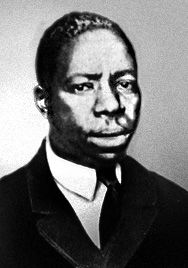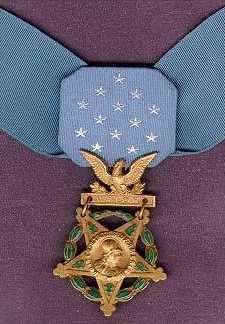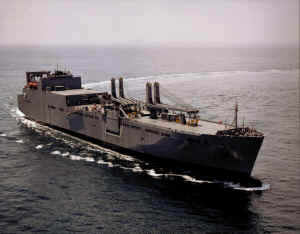Monday Maritime Matters
December 3rd, 2007 by xformed
He was a man who saw his service to others more important than his own life in dire circumstances: Pvt George Watson, US Army.


Citation: For extraordinary heroism in action on 8 March 1943. Private Watson was on board a ship which was attacked and hit by enemy bombers. When the ship was abandoned, Private Watson, instead of seeking to save himself, remained in the water assisting several soldiers who could not swim to reach the safety of the raft. This heroic action, which subsequently cost him his life, resulted in the saving of several of his comrades. Weakened by his exertions, he was dragged down by the suction of the sinking ship and was drowned. Private Watson’s extraordinarily valorous actions, daring leadership, and self-sacrificing devotion to his fellow-man exemplify the finest traditions of military service.
In more detail, here are the circumstances of the story in Wikipedia:
A resident of Birmingham, Alabama, He had entered the Army September 1, 1942, and was a member of the 2nd Battalion, 29th Quartermaster Regiment. He was a passenger aboard the Dutch steamer USAT Jacob on March 8, 1943, which was near Porloch Harbor, New Guinea, when the ship was hit by Japanese bombers.
When the ship was abandoned, Watson remained in the water and, instead of trying to save himself, assisted soldiers who could not swim into life rafts.
Weakened by his exertions, he was dragged down by the suction of the sinking ship and drowned. His body was never recovered.
Pvt Watson is one of seven African-Americans to have been awarded the Medal of Honor in WWII. However, his award did not happen until 1990, when, of ten names of African-American heroes were submitted for upgrading/award for the MOH, did he become one of those seven, and all of them honored decades after their courageous acts. In 1997, President Clinton made the presentations. The other six awardees all served with line combat units. Pvt Watson, alone, of the Quartermaster Corps, received this high honor, from a non-combat unit.
To remember this hero, who had no known family, a field at Ft Benning, and the courthouse for Jefferson County, GA have been named for him.

USNS Watson will be assigned to MSC’s Afloat Prepositioning Program which prepositions on ships equipment and supplies for the U.S. Army, Marine Corps, Navy, Air Force and the Defense Logistics Agency worldwide. Prepositioning improves U.S. capabilities to deploy forces rapidly in any area of conflict.
Watson is scheduled to be loaded with U.S. Army cargo in September (1998). USNS Watson will be crewed by 29 merchant mariners from Maersk Lines Limited under contract to MSC. In addition, up to 50 military personnel can embark to “monitor and maintain the military equipment on board, ensuring its readiness.
By the year 2001, MSC will have taken delivery of 19 LMSRs as part of the U.S. Navy Strategic Sealift Acquisition Program. The program is in response to the need for expanded sealift capability identified in a congressionally mandated study done in the early 1990s. The 19 LMSRs will provide five million square feet of sealift capacity early in the next century.
Large, Medium-speed, roll-on/roll-off ships – T-AKR Description: Military Sealift Command’s newest class of ships – Large, Medium- speed, Roll-on/Roll-off Ships, or LMSR – will significantly expand the nation’s sealift capability in the 1990s and beyond. Nineteen LMSRs will have been converted or built at U.S. shipyards by the year 2001.
Features: Large, Medium-speed, Roll-on/Roll-off Ships, or LMSRs, can carry an entire U.S. Army Task Force, including 58 tanks, 48 other track vehicles, plus more than 900 trucks and other wheeled vehicles. The ship carries vehicles and equipment to support humanitarian missions, as well as combat missions. The new construction vessels have a cargo carrying capacity of more than 380,000 square feet, equivalent to almost eight football fields. In addition, LMSRs have a slewing stern ramp and a removable ramp which services two side ports making it easy to drive vehicles on and off the ship. Interior ramps between decks ease traffic flow once cargo is loaded aboard ship. Two 110-ton single pedestal twin cranes make it possible to load and unload cargo where shoreside infrastructure is limited or nonexistent. A commercial helicopter deck was added for emergency, daytime landing.
Not only is this ship named for him, as the first of the several units in the class, they will all honor Pvt Watson as the WATSON Class T-AKR-310 ships.
Pvt George Watson’s Medal of Honor is maintained at the US Army Quartermaster Museum at Ft. Lee, VA.
His legacy is to continue to provide help to others on the field of combat.
Bonus reading: Eagle1 talks about a response by government and industry to seaborne threats.
This entry was posted on Monday, December 3rd, 2007 at 11:53 am and is filed under Army, Leadership, Maritime Matters, Military, Military History, Public Service. You can follow any responses to this entry through the RSS 2.0 feed. Both comments and pings are currently closed.
December 7th, 2007 at 3:01 pm
Those LMSR’s are sweet cargo ships. Having loaded and unloaded almost every type of Pre-positioned Maritime Support ship, the LMSR’s in 2003 were a welcome change. Clean, easy to load/unload, safe. It was nice. Even in Kuwait. We could unload one in 2 days.